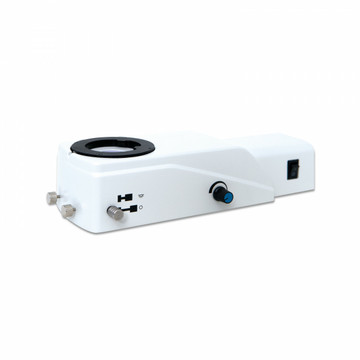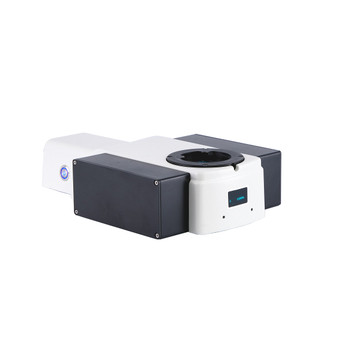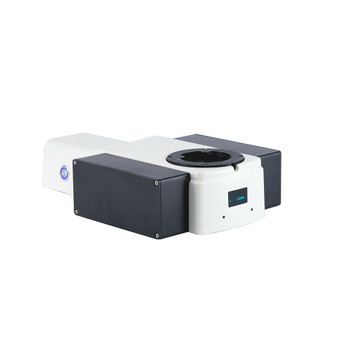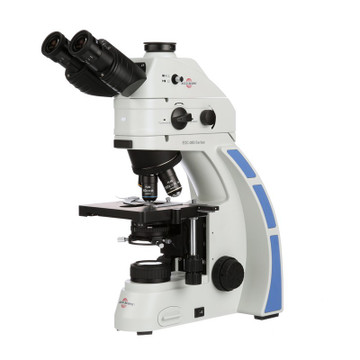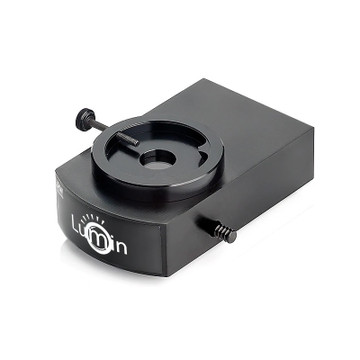
-

-

-

ACCU-SCOPE 3231-B Single Channel Fluorescence Illuminator, Blue Excitation
€3,889.64€4,321.82 -

-

-

-

-

-

-

ACCU-SCOPE 3231-G Single Channel Fluorescence Illuminator, Green Excitation
€3,889.64€4,321.82 -

ACCU-SCOPE 3231-Y Single Channel Fluorescence Illuminator, Yellow Excitation
€3,889.64€4,321.82 -

Fluorescence Microscopes are most commonly used for biological research, environmental monitoring, public health, and medicine. One of the greatest advantages of Fluorescence Microscopes is that it enables the viewer to obtain faster laboratory results that would not be seen under a routine light microscope.
Types of Fluorescence Microscopes
Here are some explanations on the popular types of fluorescence microscopes we sell:
Epi-fluorescence Microscopes
Epifluorescence (or epi-fluorescence) microscopes are the most common type of scope used to observe fluorescence in sample specimens and are almost always used for life science work to observe usually difficult to detect organic samples. The sample is illuminated through the objective lens using excitation wavelength light. The dichroic beam splitter (or dichroic mirror) helps to filter the image, by reflecting the remaining excitation light back towards the sample. The excitation of the fluorophore and the detection of the fluorescence is done via the exact same objective.
You can shop all epifluorescence microscopes here.
LED Fluorescence Microscopes
LED fluorescence microscopes tend to be a lot cheaper than mercury vapor fluorescence microscopes, and are also a lot less expensive to maintain because the main diodes are more durable, they can be used immediately after turning on, and they contain no toxic products.
Browse all LED fluorescence microscopes here.
Upright Fluorescence Microscopes
Upright fluorescence microscopes observe the sample from above, with the light source and condenser located below the staging point, facing upwards.
Browse all upright fluorescence microscopes here.
Inverted Fluorescence Microscopes
An inverted fluorescence microscope is a normal fluorescence microscope where the light source and contender are on the top, above the typical staging point, facing downwards. The objective lens and eyepieces are set below the staging point facing up.
They are popular with live-cell imaging because cells sink to the bottom of the sample, and you can easily modify liquid samples from the top.
You can shop inverted fluorescence microscopes here.
Confocal Fluorescence Microscopes
Confocal fluorescence microscopes use optical imaging techniques to give greater optical resolution and contrast for micrographs, using a spatial pinhole to block any out of focus light during the image formation.
This technique is popular among life science experts, semiconductor inspection, and those working in industry/material sciences.
Widefield Fluorescence Microscopes
A widefield fluorescence microscope uses widefield microscopy to permanently illuminate the whole sample, using light sources such as LED/Xenon Arc Lamp/Halogen/Metal Halide Lamps/Lasers, using the fluorescence contrast method.
This differs from a confocal microscope, which uses confocal microscopy to only illuminate one part of the sample at once.
Fluorescence Microscope Cameras
Our fluorescence microscope cameras enable you to capture low-level fluorescence emitted from your sample, with high sensitivity and low noise features, to ensure you can capture the maximum amount of photons from your sample with the least amount of noise.
Fluorescence Microscope Specifications
The specifications of our fluorescence microscopes vary depending on the model, and they include different:
- Viewing Heads: Binocular or Trinocular
- Objectives
- Magnification
- Filters
- Fluorescence Type
- Illumination (LED, Mercury Fluorescence)
- Microscope Camera
You can filter the results on our website.
Fluorescence Microscope Magnification
Resolution and magnification are not the same in microscopy. Resolution refers to how much detail you can see, and magnification is how much larger you can amplify the image. There's no point in seeing a highly magnified image if you can't make out enough fine detail.
Using fluorophores to stain a cell structure, we can use filters to focus on the light emitted from the sample. This gives you a high resolution because it makes the cells contrast better with others. This also allows you to take images in more than one color.
Common Applications of a Fluorescence Microscope
Fluorescence Microscopes are used in the study of both organic and inorganic matter, living cells and cell biology, organelles, single molecules, fluorescent proteins, tissue samples, and antibodies.
What is fluorescence microscopy and how do fluorescence microscopes work?
Fluorescence microscopy uses fluorescence and phosphorescence to examine the structural organization and the spatial distribution of samples. It is particularly used to study samples that are complex and cannot be examined under a conventional transmitted-light microscope.
Fluorescence Microscopes use an extremely high-intensity light to generate an image to illuminate the sample being studied. This release of light has a longer wavelength, which is what causes the fluorescence in the sample. Various stains are used in conjunction with the specimen in order to facilitate the fluorescing process. It uses the release of light by a stained substance that has taken in either light or other electromagnetic radiation. The fluorescence then emitted by the sample is focused by the objective lens into the detector. The emitted light is then separated from the weaker fluorescence by using a spectral emission filter, letting the desired longer emission wavelengths of light through to be observed. You will often have one optical block/filter cube on the microscope, containing the light illuminators, the excitation filter, the dichromatic mirror, and the barrier filter.
This method has a high signal to noise ratio.
There are a few typical components in a fluorescence microscope:
- Light Source
- Excitation Filter
- Dichroic Mirror
- Emission Filter
Earlier types of fluorescence microscopes include the use of xenon, halogen, and the most commonly used today are with mercury bulbs - all powered by an external power supply. As technology constantly evolves, manufacturers have introduced alternative fluorescent light sources, including Metal Halide and LED Fluorescence. They are more expensive but the bulbs have considerably more longevity, thus greater savings in the long run.
The process of creating the image is known as fluorescence imaging.
How much does a new fluorescence microscope cost?
A fluorescence microscope can cost between $2,400 and $21,000+ depending on the specifications and customizations that you require.
What is Photobleaching?
Photobleaching describes one of the disadvantages of using a fluorescence microscope. It occurs when the excited electrons cause chemical damage to the sample and limit the length of time you can view a sample with this technique.
Custom Quotations for Fluorescence Microscopes
Let our experts create a custom quote just for you with our best pricing and terms. Simply tell us your requirements and we'll do the rest.
Request a QuoteIf you need product advice, technical support, or to enquire about quantity discounts, feel free to contact us by email or call us at (877) 877-7274.
New York Microscope Company is the only microscope company to offer Free Service Protection Guarantee with the purchase of every microscope. Visit our Free Service Protection page for more details.



